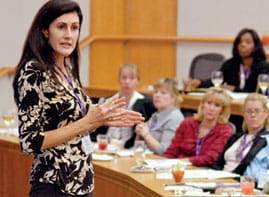Keys to ‘leading an agile recovery’
Managers need to get focused, identify weaknesses and set objectives, said speakers at the Kellogg Turnaround Management Conference
By Chris Serb ’094/13/2010 - Metaphors flew freely April 7 around the James L. Allen Center at the fourth annual Kellogg Turnaround Management Conference, themed “Leading an Agile Recovery.”
Several hundred attendees heard about how to bail out a sinking boat, steer a ship on a zigzag course, resuscitate an ER patient, and most of all, do the dirty work.
The conference opened with a keynote speech from Gary McCullough ’87, president and CEO of Career Education Corporation, a Hoffman Estates, Ill.-based company that manages post-secondary schools. In 2006, the once-high-flying firm suffered from earnings disappointments, falling stock prices, and the resignation of the founding CEO. McCullough arrived in March 2007 and quickly determined the source of CEC’s downturn.
“I saw three key reasons beyond the company’s problems: failure to focus on quality, especially with the regulators; failure of the management team to evolve as the business matured; and failure to knit our acquisitions together,” McCullough said. “We had 46 unaligned compensation plans. We bought computers from 12 different manufacturers. We weren’t leveraging the scale of a $2 billion business.”
McCullough immediately attacked those problems by recruiting new talent; addressing cultural issues that affected quality; focusing on cost control and purchasing efficiency; and most importantly, holding employees accountable for newly measured performance goals.
When McCullough announced his plans to analysts and set ambitious three-year targets, CEC’s stock dropped near his team’s all-time low. But he pressed on with his plan, and CEC hit most of its goals in 2009 — one year ahead of schedule.
“Having that action orientation was critical for us in the early stages,” McCullough said. “Other things like long-term strategy are important, but I had to keep saying ‘We really can’t do that right now.’ It’s a tricky balance, but I think we were able to do it effectively.”
McCullough’s focus on action resonated with speakers at a panel on “Recruiting Turnaround Professional Executives,” moderated by James B. Shein, clinical professor of management and strategy at Kellogg.
“People who are very good at turnarounds tend to view these things as projects,” said panelist Lou Kacyn EMP-24, an executive search consultant with Egon Zehnder International. “They’re very goal-oriented, they have timelines in mind and specific objectives they want to accomplish. But they have to be patient in other ways, like talking about strategy or growth. They need to say ‘Recovery is all that we’re focusing on,’ regardless of how much everyone else wants to get on with other things.”
Panelist Jim Mesterharm ’99 emphasized the need for speed and flexibility among turnaround executives.
“You have to make decisions; a non-decision is a decision itself, and it backfires,” says Mesterharm, managing director of AlixPartners, who specializes in filling interim executive roles at troubled companies. “If what you try isn’t working, you need to change directions on the fly, and many people can’t navigate those waters.”
Of course, any successful turnaround plan needs board support, an issue addressed by panelist Michael Buenzow, senior managing director with FTI Consulting. He outlined four common types of directors: those with agendas, including activists; clueless, passive individuals; harried executives at other companies who have little time for board duties; and committed, well-informed directors who understand the steps that need to be taken.
“Hopefully, aligning yourself with that faction of the board can get the rest of the board to move for the good of the company,” Buenzow said. “Successfully managing the boardroom dynamics can be key to whether a company gets in and out of distress in a decent amount of time, or pays for it later.”






